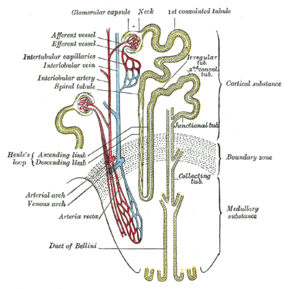Collecting duct
| Collecting duct system | |
|---|---|

Scheme of renal tubule and its vascular supply.
|
|
| Details | |
| Identifiers | |
| Latin | tubulus renalis colligens |
| MeSH | Kidney+Collecting+Ducts |
| Dorlands /Elsevier |
12830107 |
| FMA | 265239 |
|
Anatomical terminology
[]
|
|
The collecting duct system of the kidney consists of a series of tubules and ducts that connect the nephrons to the ureter. It participates in electrolyte and fluid balance through reabsorption and excretion, processes regulated by the hormones aldosterone and vasopressin (antidiuretic hormone).
There are several components of the collecting duct system, including the connecting tubules, cortical collecting ducts, and medullary collecting ducts.
The segments of the system are as follows:
With respect to the renal corpuscle, the "connecting tubule" is the most proximal part of the collecting duct system. It is adjacent to the distal convoluted tubule, the most distal segment of the renal tubule. Connecting tubules from several adjacent nephrons merge to form cortical collecting tubules, and these may join to form cortical collecting ducts. Connecting tubules of some juxtamedullary nephrons may arch upward, forming an arcade.
The connecting tubule derives from the metanephric blastema, but the rest of the system derives from the ureteric bud. Because of this, some sources group the connecting tubule as part of the nephron, rather than grouping it with the collecting duct system.
The initial collecting tubule is a segment with a constitution similar as the collecting duct, but before the convergence with other tubules.
The "cortical collecting ducts" receive filtrate from multiple initial collecting tubules and descend into the renal medulla to form medullary collecting ducts.
"Medullary collecting ducts" are divided into outer and inner segments, the latter reaching more deeply into the medulla. The variable reabsorption of water and, depending on fluid balances and hormonal influences, the reabsorption or secretion of sodium, potassium, hydrogen and bicarbonate ion continues here. Urea passively transports out of duct here and creates 500mOsm gradient.
...
Wikipedia
